Day 11: November 20
We awoke to a sense of anticipation and to heavy rain. I put the white and green stones in my pocket again; they were starting to feel lucky. We had apple strudel at the café and set out for Queenstown.
Rainy weather has its own kind of special beauty. As we drove along and looked out across the lake we could see the base of the mountains on the other side of the water, then a thick layer of cloud, and then we could just barely see the very tops of the mountains, peaking out through the mist.
We came back into Queenstown, often referred to as the “Adventure Capital of the World.” Amid dozens of offices for activities ranging from white-water sledging to parachuting, we found the headquarters for A.J. Hackett’s Bungy Jump, and we stopped in for a look. We watched some videos of people jumping and saw many photos. Of particular concern to me was the picture of a jumper at the full extension of the bungy, just before being bounced back up, with his head in the river; they call this the wet landing! We talked to some of the employees about what bungy jumping was like, and tried to work up our nerve. I decided to go ahead and book a spot before we drove out to the bridge; I was trying to talk Jineen into doing the same but she was reluctant. But then we found out that if you don’t jump for any reason, even because you chicken out at the very last minute, you get a full refund! This was the clincher; Jineen signed up on the spot. Peer pressure is a wonderful thing!
As I have mentioned before, I have a fear of heights. I love the view from a high place, but I don’t like to be too near the edge and look down. If I am on a high balcony, I can’t lean on the railing because I’m afraid it might unexpectedly collapse underneath me. On a cliff, I cannot bring myself to stand too near the brink for fear of tripping and falling; and even if I sit down, I worry that the ledge I am on will suddenly crumble away. I was concerned that this phobia might interfere with my ability to bungy jump!
In fact, bungy jumping has always been something I have had no interest in doing. More than that, in fact, I had always pretty vehemently felt that it is something I would NEVER EVER do. Why then, you ask, did I want to subject myself to it now? I have no idea! But the truth was, at this point, I really did want to do it. But the question was; could I?
I had been working for days on psyching myself up into the right frame of mind. Here was my theory: my fear of heights is a rational fear. When I am on a cliff or in a high place, I am afraid I will klutz out and trip, go off the cliff, and fall to my death on the rocks below, or whatever. And that could well happen! So it’s not an irrational fear, it is a very logical one. But with bungy jumping, logically and rationally, I do not believe it is really (very) unsafe; at least not when it is conducted by professionals who know what they are doing. So therefore, since with the bungy jumping I know I am going to jump off of the edge, and that I will be secured by the bungy and am therefore unlikely to die, my fear of heights shouldn’t apply. Makes sense, doesn’t it? Now, I just had to convince myself!
Our scheduled time to jump was around one o’clock in the afternoon, and as it was still mid-morning, we took a side-trip on our way to the bungy site. We took the turnoff to go and visit another LOTR filming location; the ‘Pillars of the Kings’ on the Anduin River. This was in a deep river gorge just upstream from the bungy bridge, and we had a good view from the entrance road of the Chard Farm Vineyard. The water was very swift, and with the rocky cliffs on either side you could really imagine the huge stone kings looming high above the river.
A.J. Hackett’s Bungy Jump is the oldest commercial bungy jumping company in the world, and the Kawarau River Bridge, where we were headed, is the original bungy jumping site, operating since 1988. It is an old railway bridge, converted to its current use, and it spans the gorge 150 feet above the Kawarau River. We parked the car and went out onto the viewing deck to watch.
|
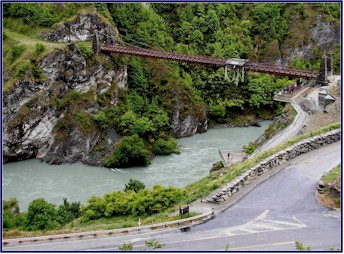
Kawarau
River
Bungy Bridge
|
By the time we arrived it was starting to rain fairly hard, and the wind was really picking up. Standing on the bridge preparing to jump was a guy named Sean, who was wearing no shirt; he was going for the ‘wet landing.’ He was on his ‘stag run’ before getting married; and his friends were merciless. “Sean, you’re going to die!” they were yelling from where they stood next to us on the observation deck. “Sean, we’re never going to see you again!” and “Suck in the gut, Sean, there’s people with cameras over here!” Tough crowd! After several minutes of this abuse Sean dove off the bridge; the bungy pulled him up just inches from the water, so his head didn’t go into the churning river as planned. After 4 or 5 decreasing bounces they lengthened the bungy to lower him so the rescue dinghy could pick him up; but to the delight of Sean’s friends, as those guys pulled him into the boat they first dunked him into the freezing river!
|
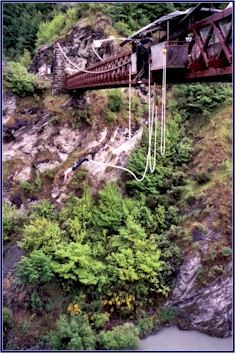
Sean
|
After watching several more jumpers, with some trepidation we went inside. There was a gift shop and an observation area, and a nice café; but for some reason we didn’t feel much like eating lunch. We watched as a girl in a bright pink sweat suit stood on the platform; for the longest time she couldn’t bring herself to jump. The guys working on the bridge would say, “All right, ready; 5, 4, 3, 2, 1, Go!” but she would just stand there. They were very patient and encouraging; they must have given her the countdown 15 times before finally, with a shriek, she jumped. I was worried; that could be me! I could well imagine myself standing on the brink while they counted me down, unable to bring myself to actually go off the edge. When the girl in pink came back up to the viewing room a bit later on, Jineen, who I suspect was still contemplating desertion, asked her how it was; she said enthusiastically that once she made herself go, it was great!
The moment was getting closer. We checked in and paid our money. One of the most important aspects to bungy jumping is getting the length of the bungy right; this is based on the weight of the jumper. Not the time to lie about your weight! But they don’t give you that opportunity; rather than ask your weight they just have you step on the scales. They then write your weight (in kilos) on your hand as well as on your jump pass.
Soon it was time to go out onto the bridge. I was less nervous than I had expected to be; I was feeling very eager. I continued to remind myself that my acrophobia would not apply today.
There were two lines; on one side it said ‘59 and under,’ and on the other it was marked ‘over 60.’’ At first I was amazed that there were enough bungy jumpers over 60 years old to require their own line; but then I realized that those numbers referred not to your age, but to your weight in kilos! Thus, Jineen and I ended up in different lines.
The man in front of me said that his wife had come up for her turn a little while ago; and wouldn’t jump! She had stood there while they gave her a countdown over and over, like the girl in pink; but in the end she chickened out. Still, to my surprise, I was feeling more excited than nervous; it was like being ready to go into the start box for a big cross-country course at an important Event. The girl in line behind me asked me, “How can you not be terrified?” I flippantly told her I was scared to death, but really I wasn’t. However, I did still have doubts about whether when it came down to it, would I actually jump!
Soon it was time to put on the equipment. Even though I was to be secured by my ankles, there was a safety belt that went around my waist, ‘just in case,’ they said. Just in case what?!? In case my ankles break off? Actually, there are several options available; if you prefer you can be secured by a body harness instead of by the ankles, so that you jump in a sort of sitting position instead of head first. I had considered this, fearing stress on my artificial knee, but I felt that if I was going to bungy jump then I wanted to do it right. No wimpy body harness for me!
As luck would have it, Jineen’s number came up first. A guy with impressive dreadlocks hooked her up by the ankles and helped her shuffle out to the edge of the platform. Just in time for her turn, the wind picked up considerably and the rain started coming down in sheets. Jineen stood on the edge for a few seconds, and then she executed the most beautiful swan dive into the river gorge! Awesome! OK, if she can do it, then so can I!
Then it was my turn. I crawled through the opening between the beams and sat on the mat where they hook you up. I was surprised there was no briefing; I asked the guy attaching the bungy if there was anything I needed to know. He replied, “What do you want to know?” He did advise me not to jump, but to dive head first, like diving into a swimming pool.
He wrapped a thick towel tightly around my ankles, and then secured the bungy line around them. As he was doing this, I was suddenly struck by a very strong sense of déjà vu, like I had been there before; it was a very eerie feeling! Then it was time to go. Standing up with my ankles tied firmly together, I awkwardly inched my way to the brink; they call this the bungy shuffle!
I had mentally geared myself up to jump on the first try; I was afraid that if I hesitated I might be there all day. The countdowns they used were very quick; not the counting off of seconds I expected, but a very rapid 5 4 3 2 1. I dove off immediately at the countdown. Don’t think, just fly!
For a moment I did feel like I was flying, as I soared forward in a dive; but in the next instant I realized with a kind of inappropriate surprise that the air didn’t support me at all, and I was falling like a rock, head first! I had an instant of, “Oh s**t, what have I done,” and then a thrill of adrenalin and fun as I realized that of course I was dropping like a stone, I was supposed to! Oh my god, what a rush! It was so much more fun than I had imagined it would be. Kuh-ool!
|
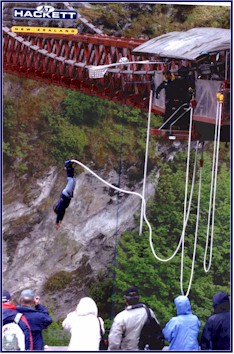
Phyllis takes the
plunge!
|
I was laughing like mad by the time I hit the end of the bungy, my head just a few feet above the water, and then I was bounced back almost all of the way up to the bridge. After about four more progressively smaller bounces, they lowered me down to where the little yellow rubber dinghy could come get me. It maneuvered over to where I was dangling by my ankles, and the guys in it held out a pole for me to grab and they pulled me in. They told me to tuck my chin in to my chest, then they rolled me into the boat, unfastened my ankles, and ferried me over to the shore, where I climbed the steep steps up to the top of the cliff.
Jineen was as excited as I was. We were both on a real adrenalin high, like the feeling you have after jumping around a really tough cross-country course. Definitely not something you would do on the bus tour! We also felt a strong sense of accomplishment, much more so than I would have expected; I think it is something you don’t truly understand until you do it. So for all you critics out there who think bungy jumping is stupid (I used to be one of them), try it before you knock it!
We went back in to the building, where they had our photos ready for us (for an additional fee, of course). Jineen bought the video of her jump; it showed her great diving form. She told me that she had always wanted to do a really great swan dive off of a high diving board, but had never quite dared to for fear of belly flopping. So she had figured this was her chance! We went back out to the bridge and thanked the guys who worked there; Jineen got her friend with the dreadlocks to sign her photo. Then with a satisfied sense of achievement, we took to the road again.
Leaving the Queenstown area, we had a misty view of the Remarkables, the incredible rugged mountain range that stretches south-east of town, and then we headed east through Cromwell. This was the only day it had really rained on us yet, and if you have to get a little wet sometime, bungy jumping was as good a time as any; better than while hiking! But as we drove on, the rain stopped and the sun came out; before long it was a beautiful sunny day.
As we traveled further east, the scenery changed; it was much drier here, and many of the steeper slopes had large areas of rock and scree. The hills and mountains were all in shades of browns and grays, with accents of white snow; the colors blended like swirls of paint on a palette. Pale heather was blooming on the hillsides. The only bright color came from the lupines, which were growing along the sides of the road all through this region; we wondered if they grew wild or if they had been planted there.
Unexpectedly, we came to a huge field that was completely covered with lupines in bloom. It was spectacular! We parked by the side of the road and walked through this brilliant meadow. The flowers blanketed the field, the hillside, and the valley that ran down along a stream; with the mountains standing tall beyond. It was a riot of colors; there was every shade of purple from light lavender to deep violet, three kinds of pink, a dark red, burgundy, salmon, purplish blue and white.
We spent quite a while there, just walking among the flowers and enjoying the peaceful beauty of this marvelous spot; and taking way to many photographs! One of the best things about this place was that it was just a chance discovery, something we happened upon as we drove along; we were glad we had the opportunity to stop and enjoy it. Invest in the Journey!
We went over Lindis Pass; its tall steep mountains were very barren, almost desert-like, with brown grass tufts and nothing green. Looking down from the pass we saw hills and slopes all in shades of brown and tan; they reminded us of sand dunes. The river valley ahead of us was filled with lupines; it looked like a wide river flowing purple among the bleak hills surrounding it. We passed the Clay Cliffs; as the name implies, these were impressive cliffs of clay, formed from the hillside by erosion.
|
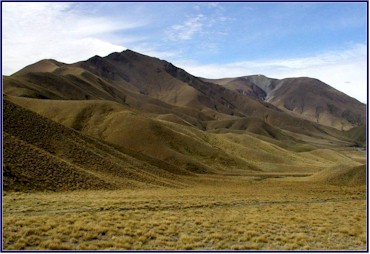
Lindis Pass
|
As we approached the town of Twizel we passed Lake Ruataniwha; its color was beyond belief. We had continually seen lakes and rivers that I have described as turquoise or blue-green, but the water here was of such an intense aqua color that people don’t believe it even when they see the photos. As we continued on we occasionally got glimpses of Mt. Cook in the distance, clouds ever hovering around its peak.
Our map showed another golden ring; we went searching for the ‘Pelennor Fields.’ We turned off on a small side road and followed a canal of the same brilliant green-blue water, from Lake Ruataniwha back towards the mountains. We came to a broad flat plain ringed with brown hills, complete with snowcapped mountains in the background; it matched perfectly the picture in our LOTR guidebook.
We went in to Twizel to find lodging, but all of the hotels and B&Bs were booked solid. After making numerous calls (it was one of the rare occasions when our cell phone was receiving signal), we found a room at a B&B north of town; it was on an 18,000 acre sheep station called Rhoborough Downs. After several wrong turnings we found the little farm lane, but we were unsure which house it was so we missed it; we ended up driving several miles out into the middle of the farm before turning back to find the right place. To our delight, it turned out that we were staying right next door to the ‘Pelennor Fields’!
The lady who ran the B&B told us that the farm had been in her family for over 80 years. This was the first place we had stayed that had a long family history! When we visit Ireland, the country has a very traditional way of life and a long and ancient history, and we often stay with people whose families have been in the same house for generations. New Zealand is a much younger country, and the influence of people who have immigrated there from all over the world was evident; we found it to be more cosmopolitan, much more of a melting pot. But universal traits of the NZ people seems to include a friendly and helpful personality, and a ‘can do’ attitude, the ability to improvise and find a way to make things work with whatever tools and supplies are available.
We had an excellent dinner in town, and studied the guidebook a bit. We had the ‘Lonely Planet’ book on NZ, and it had proved very useful throughout the trip. Each time we visited a new area we would look it up, and this guidebook not only listed points of interest and suggestions for dining and lodging, but it also told us some of the history and local lore, and gave us other bits of random information. We learned, for instance, that a thar is a type of mountain goat; we had been wondering ever since seeing them listed on a hunting sign. The large black, brown and white birds we had seen several times swooping over fields and streams are called Oyster Catchers. We also read about Mt. Cook. It is known to the Maori people as Aoraki, and at 3755 meters (that’s 12,392 feet), it is the highest peak in New Zealand. Sir Edmund Hillary climbed it in preparation for his first ascent to the summit of Everest.
We came outside to a brilliant pink sunset. We took a trip up to Lake Pukaki and found a place where we could drive on a little track right down to the shore. Even in the twilight the water was that same superb shade of bright turquoise, and in the dim lighting the lake seemed almost to glow. A stiff wind was blowing little white-capped waves to the shore, and the silhouettes of the mountains were still visible in the growing darkness. Across the lake, Mt. Cook could be seen, gleaming white amid other lesser peaks. We stood there a long time.
When we went to our room and got ready for bed, I put my hand in my pocket; there were the two small rocks, the green stone and the round translucent white one. The rocks that I kept meaning to cull, to leave behind. And now they had bungy jumped with me! And they had proved brave and loyal (unlike my jade necklace, which tried to escape while I was dangling upside-down above the Kawarau River). To hell with the overweight baggage excess, I knew I would not leave these stones behind now; we had been through too much together!
Day 12: November 21
We had breakfast with Roberta, the owner of the farm, and a couple from Scotland who were staying there. It was a rather bland group; we tried to make conversation, but the Scottish couple proved to be fairly uncommunicative; all of our questions were answered in monosyllables, and they showed no interest in anything we had done. These were the first people we had met on the trip who weren’t friendly! However, Roberta was quite interested in hearing about the field of lupines and wanted to know where it was; she had a lovely garden, and we imagined that she might make a trip right out to see them! She told us that a local woman, who had been born in NZ but had traveled to England, had brought lupine seeds back with her and planted them along the roadsides all over this area of the country, much to the chagrin of the Department of Conservation, who considered them an introduced species. As disastrous as importing possums had proved to be, we felt that the addition of the lupines was a good one, as they added a bit of color and brightness to some of those areas that were quite drab and brown otherwise.
We had quite a lot of ground to cover, so we headed out early. We stopped again at the amazing Lake Pukaki, for a morning view of Mt. Cook. We followed a little four-wheel drive track that took us right down to the waterside. It was an absolutely delightful morning; clear blue sky, brilliant turquoise lake, Mt. Cook covered with snow, and the sunniest day we’d had yet. Our trip was still blessed!
There was so much to see and to do in New Zealand, and of course we didn’t have time to do everything we would have liked to. We wanted to cover as much of the country as possible, but we didn’t want to put so much on our schedule that we couldn’t afford the time to ‘stop and smell the lupines.’ There were hundreds of small roads and tramping tracks marked on our map that we would have liked to explore; we found ourselves really envying some of the people we had met who were spending several months or more seeing NZ! We made the decision not to drive up to Mt. Cook, even though we would have liked a closer look at it. This was mostly because it was on the main route for the tour buses, and we preferred our way of exploring the less traveled places. Also, we had some other plans for the afternoon!
Heading east, we soon came to Lake Tekapo; it was the same amazing aqua color. There was a charming chapel by the lake, it was called ‘The Church of the Good Shepard,’ and there was a statue of a sheepdog by it. We realized that we had seen very few churches in NZ; in fact this was only about the second one we had noticed! We continued on to Burke’s Pass; once we crossed over this everything was much greener, with forests of pine and valleys golden with broom. We realized how much harder farming must be in the more barren dry areas we had just left, and how much more acreage it required to support the livestock.
We passed through the town of Fairlie, and continued east. We noticed on our map a point marked as “Maori Rock Drawings.” We hadn’t seen a whole lot of the Maori culture on the trip, so we decided to stop for a look. It was a bit off the beaten path; we turned onto a small road through a place called ‘Beautiful Valley.’ We passed some nice farms, one with a really neat farmhouse sitting at the top of a high cliff. We navigated by the map until we found the rock drawings.
I am sure that the Maori people are very artistic, and that there are many inspirational examples of their history and culture displayed in the form of beautiful ancient art. This, however, was not one of them! What we found was a fairly large rock overhang with some blotches of red paint and some streaks of white, with no distinct pattern or recognizable figures. As far as we were concerned, there was nothing there that couldn’t have been bird droppings or bat guano; in fact we noticed a rather unpleasant smell, so this might not have been too far off the mark! But the entire rock drawing wall was partitioned off by metal bars, to keep anyone from touching it. Obviously someone had gone to great lengths to protect this national treasure, so maybe we were missing something! We looked around a bit, and made some derogatory remarks about ancient Maori cave painters that probably demonstrated our ignorance, then headed back to the car.
|
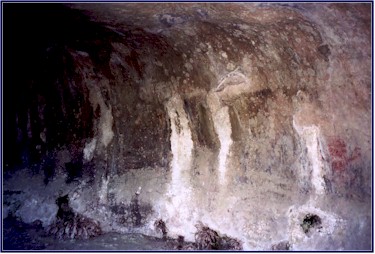
Maori Rock
Drawings
|
Although we had found the cave art anti-climactic, it was still a pleasant diversion. And as we returned to the car, we saw a small grayish bird with a silvery-white ring around its eyes; Jineen looked it up in her recently purchased NZ bird identification book, it was aptly named a ‘Silvereye.’ So we headed back to the main road having both appeased our curiosity and sighted a new bird. And, Beautiful Valley IS!
We were now into more civilized-looking farm country; we were once again seeing paddocks of lush grass, surrounded by high hedge windbreaks, and filled with herds of red deer (some with fawns), cattle and wapiti. We made a pitstop in Geraldine for petrol and some takeaway food; we had a picnic destination in mind.
We amused ourselves by counting dead possums along the road. In a distance of 10 kilometers we counted 9 carcasses, then 6 possums for the next 10 km, and 6 again for the following, and the remains of 11 possums in the final 10 km of our test area. Doing the math, we figured we were averaging .8 dead possums per kilometer. As we had already put over 2,000 kilometers on our rental Honda, that meant approximately 1,600 possums, on the South Island alone! (Yes, we are easily amused!)
We went north, and then at Mt. Somers we turned west again. Following an unsealed gravel road, we were heading once again into rugged mountain back-country. We passed hidden lakes and rocky river gorges, and golden valleys of broom and gorse, all overlooked by high white peaks. We were in a very remote area; few people lived there and even fewer visited. We drove on for mile after empty mile without seeing a soul. We came to Mt. Potts Station, a huge sheep station, but it appeared deserted. The small winding road climbed steadily up; and then it curved around a shoulder of mountain and revealed a valley before us, and a view that took our breath away. We had found Edoras!
|